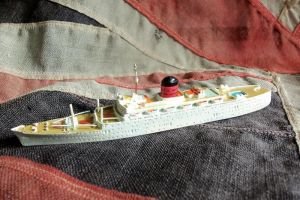RMS Franconia M 708 Triang Minic Ships 1959-64 Repainted
Price: NZ$43.42
Code: BH1176
RMS Franconia M 708 Triang Minic Ships 1959-64 Repainted White
This is the Tri-ang Minic Ships model of RMS Franconia. A model in metal by UK maker Triang Minic, from the original ‘built in Britain’ series produced in the early 1960s. RMS Franconia, is a hard to find of the Triang range. Made in very limited numbers right at the end of Triang’s production and not just a different colour (came out in green) but a completely new casting with a remodeled stern, to reflect the real ships new role as cruise liner. Model has been repainted and in a play worn condition, with all masts intact, decks have been painted brown. See all the images.
Near the end of 1951 Cunard Line announced their intention to build two new ships for the Liverpool – Montreal route. Not long afterwards, the plans were extended to build four ships rather than two. They were designed to be the largest ships operated until then by Cunard on their service between the United Kingdom and Canada, while still being able to navigate the St Lawrence River to Montreal. Ivernia was built in 1955 for and then in 1963 she was rebuilt as a cruise ship and renamed RMS Franconia. She continued to sail for Cunard until being withdrawn from service and laid up in 1971. In 1973 she was sold to the Soviet Far Eastern Shipping Co. and renamed SS Fedor Shalyapin, cruised around Australia and the far East. In 1980 she was transferred to the Black Sea Shipping Co. fleet, and for a time returned to cruising in the Mediterranean and around 1989 she was transferred again, to the Odessa Cruise Co. and continued her career as a cruise ship until 1994. She was then laid up at Llichevsk, a Black Sea port 40 km southwest of Odessa, until 2004 when, as the Salona, she sailed to Alang in India where she was scrapped
This section of the shop is about the amazing original series of diecast metal ships and harbour playset accessories, produced under the Tri-ang Minic Ships name in England between 1959 and 1964. As well as the later series of models produced under the Hornby Minic name during the early 1970’s.
The “TRI-ANG” trade mark itself resulted from a play on the truism “three lines make a triangle” the “three lines” in question being the brothers William, Walter and Arthur Lines who founded Lines Bros Limited just after the First World War.
The Tri-ang Minic Ships name comes from the original manufacturer Minic Limited a subsidiary of Lines Bros Limited, owners of the famous “TRI-ANG” trade mark.
The models were produced by Lines Bros Ltd’s Tri-ang Works at Mordon Road, Merton, London SW19 with production moving to Minic Limited at Market Way, Canterbury, Kent during mid 1960.
The original range of ships and harbour accessories are waterline models manufactured to a scale of 1:1200 scale, where one inch is equivalent to 100 feet, the same scale that was used in the manufacture of ship recognition models for training Allied naval and airforce personnel during both the First and Second World Wars.
When Lines Bros Ltd was broken up in the late 1960’s the “TRI-ANG” trade mark remained with Tri-ang Pedigree, another Line Bros subsidiary which was also active in New Zealand and Australia, while the “MINIC” trade mark was transferred to Hornby together with the tooling for the Minic Ships models.
All of the models produced under the Hornby Minic name were produced in Hong Kong after Hornby moved their manufacturing in the early 1970’s. Hornby produced only a limited selection of the original models but also introduced four new models of famous battleships – USS Missouri, IJN Yamato, DKM Bismarck and DKM Scharnhorst.All of the ship models produced under the Hornby Minic name were fitted with a red plastic base equipped with plastic rollers.
The original Tri-ang Minic and Hornby Minic series of models are no longer in production and to the best of our knowledge the tooling for these models no longer exists. So the original models have become quite collectable as they were only made for 6 years and being mainly children’s toys, many sadly have not survived. What has is in various states of repair! Still they are an incredible early 1960’s toy which can be arranged in attractive displays, and enjoyed in many homes or businesses where a nautical theme is desired.




